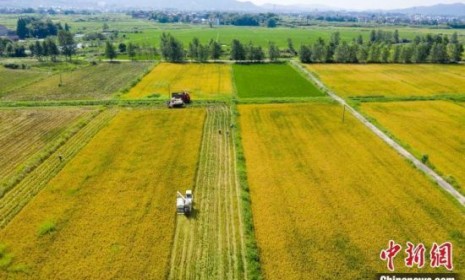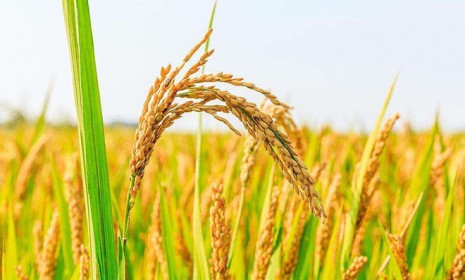近日,华中农业大学园艺植物生物学教育部重点实验室果树栽培团队在Plant Physiology 上发表了题为 “ABF4 and ABR1 synergistically regulate amylase-mediated starch catabolism for drought tolerance” 的研究论文,报道了柑橘资源通过ABF4-ABR1转录调控模块促进干旱环境下β-淀粉酶(BMA3)介导的淀粉降解、提高可溶性糖含量增强抗旱性的分子调控新通路。
柑橘是目前世界第一大产业果树,也是世界第三大贸易类农产品,其种植面积、产量以及进出口量均居各类水果之首。我国大部分柑橘产区处于南方丘陵地区,立地条件差、灌溉条件有限,并且伴随着近年来全球气温升高和南方季节性缺水频发,干旱成为制约柑橘产量和品质的重要逆境因子之一。因此,发掘干旱胁迫应答功能基因和解析其分子调控通路对改良柑橘抗旱性有重要指导意义。
可溶性糖作为一种重要的渗透保护剂,在植物逆境环境适应性中发挥重要作用,BAM介导的淀粉降解是快速提升植物体内可溶性糖含量的重要路径,但是关于BAM介导的淀粉降解是否响应干旱环境及其分子调控机制目前仍不清楚。本研究发现,脱水条件下枳体内的淀粉含量降低、可溶性糖含量显著升高,这一过程与BAM3基因的表达上调和淀粉酶活性上升紧密关联。随后通过转基因方法获得BAM3过表达和VIGS干涉材料,干旱处理结果表明BAM3通过促进淀粉降解和增加可溶性糖含量提高植物抗旱能力。进一步通过启动子转录活性和转录调控机制分析表明,BAM3表达受干旱环境的明显诱导,这一过程依赖于ABA信号通路的转录因子ABF4和ABR1。Y1H、EMSA、ChIP-PCR、LUC等实验证明,ABF4和ABR1能分别特异性结合BAM3启动子区域的ABRE和GCC-box元件并激活BAM3基因表达。有趣的是,ABF4同时能结合ABR1启动子上的ABRE元件激活ABR1的表达,还能与ABR1在蛋白水平上互作,形成转录级联放大信号和转录蛋白复合体ABF4-ABR1,协同促进干旱环境下BAM3介导的淀粉降解,有效增强植物抗旱性。综上所述,本研究揭示了ABF4-ABR1-BAM3模块在柑橘干旱胁迫应答中的功能和分子调控机制,不仅为培育抗旱柑橘新种质提供重要功能基因,也为柑橘水分利用与糖分代谢积累调控提供重要参考。
华中农业大学园艺林学学院刘继红教授和李春龙教授为该论文的共同通讯作者,博士研究生张豫为该文第一作者。该研究得到国家重点研发项目(2018YFD100030)和国家自然科学基金(31772273)的资助。
英文摘要:
β-amylase (BAM)-mediated starch degradation is a main source of soluble sugars that help plants adapt to environmental stresses. Here, we demonstrate that dehydration-induced expression of PtrBAM3 in trifoliate orange (Poncirus trifoliata (L.) Raf.) functions positively in drought tolerance via modulation of starch catabolism. Two transcription factors, PtrABF4 (Poncirus trifoliata ABA-responsive element binding factor 4) and PtrABR1 (Poncirus trifoliata ABA repressor 1), were identified as upstream transcriptional activators of PtrBAM3 through yeast one-hybrid library screening and protein-DNA interaction assays. Both PtrABF4 and PtrABR1 played a positive role in plant drought tolerance by modulating soluble sugar accumulation derived from BAM3-mediated starch decomposition. In addition, PtrABF4 could directly regulate PtrABR1 expression by binding to its promoter, leading to a regulatory cascade to reinforce the activation of PtrBAM3. Moreover, PtrABF4 physically interacted with PtrABR1 to form a protein complex that further promoted the transcriptional regulation of PtrBAM3. Taken together, our finding reveal that a transcriptional cascade composed of ABF4 and ABR1 works synergistically to up-regulate BAM3 expression and starch catabolism in response to drought condition. The results shed light on the understanding of the regulatory molecular mechanisms underlying BAM-mediated soluble sugar accumulation for rendering drought tolerance in plants.
论文链接:
https://academic.oup.com/plphys/advancearticle/doi/10.1093/plphys/kiac428/6697893?searchresult=1
日期:2022-09-28


















